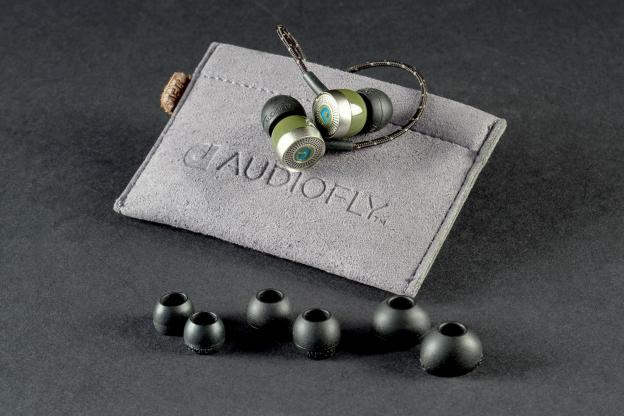“If you’re fed up with the muddy sound of the standard smartphone fare...these little buds offer a burst of clarity and presence, with a smooth punch of bass to boot.”
- Clear, open sound signature
- Smooth, powerful bass
- Good instrumental separation
- Attractive design
- Sharp upper midrange
- Very noisy cable
- Anodized caps can wear on the ears
Australian audio company, Audiofly, often has its sights set on the big fish of the audio world. The company produces a number of high-performance in-ear monitors that require a substantial investment. But recently Audiofly has joined the fight for the coveted fifty-bucks-and-under crowd with a selection of entry-level headphones, including the AF45 earbuds. Lightweight, attractive, and as well-featured as you should expect from a $50 pair of in-ear headphones, the AF45 are an enticing choice. But do they provide a performance that makes it worth tossing out the buds that came with your smartphone? We spent a few days with the AF45 to find out.
Out of the box
In contrast with many entry-level earbuds, the AF45 come in relatively plush packaging. Inside the box, we found our review sample nestled in thick foam, their army-green shells accented with bright silver caps. We couldn’t help noticing how light the buds felt once we freed them from their packaging.

In the box with the headphones we found a small user’s guide, a baggy of silicone ear tips and, to our surprise, a coin purse-style microfiber sack for hauling the buds around.
Features and design
At first glance, the AF45 seem to masquerade as a premium product, as if they fit into Audiofly’s top-tier products. The plastic shells look like porcelain from a distance, and our review model’s silver accents encircled Audiofly logos at the center, with anodized-alloy bezels that convey an air of hand-carved craftsmanship.
At first glance, the AF45 seem to masquerade as a premium product …
Inside each bud is a custom-voiced 11mm dynamic driver with a claimed frequency range of 18Hz-20kHz, and a 16-Ohm impedance rating. The backside of the housing is vented to allow for some acoustic breathing room.
Floating about six inches below the left earpiece is a small plastic bead that houses the AF45’s optional on-board microphone. The Kevlar-reinforced fabric cable meets at a single-button control piece at the center, which handles play/pause, song skip, and controlling phone calls in the Android style, with no available volume control. The cable is about four feet long, and terminates at a gold-plated 3.5mm jack.
Comfort
When it comes to in-ear headphones, comfort is always a complex issue of anatomy and personal preference. For this reviewer, the rounded edges of the buds wore pretty sharply on our ear canals after extended periods. However, when we lent the buds to a colleague, he found them to be a spot-on fit, and the shape of the outer caps seems to be designed for a larger ear shape. The tip sizes were also a little too small at the low end, particularly when compared to the next size up; we foumd ourselves wishing for more options.
Performance
The first thing we noticed when taking the AF45 for a walk around the block was an overwhelming amount of noise from the top portion of the headphone cable as it rubbed against our rain jacket. The noise was much less apparent against cotton clothing, but users beware: You’ll want to scrounge up a spare cable clip from an old set of buds before taking these babies on the road, as there was none to be found among the accessories.
When stacked up against similarly-priced options, the AF45’s overall exhibition of the sound impressed.
As we dug deeper, the 45 began to reveal a light and spindly character to the upper midrange. The thinner sound lent plenty of transparency to acoustic instruments and vocals, but we wished for more resonance and warmth there as well. Dave Matthews’ “Crush,” for instance, was instantly brighter than normal at the center, with an almost crispy quality to the attack of instruments. Calling up Sting’s “Seven Days,” revealed too much bite in the snare at the chorus, popping with a flattened, sibilant flare. In contrast, there was a bit less definition than we’d hoped for in the high treble, sounding a little chaotic and smeared when cymbals or electric guitar tracks got cooking at the climax of heavier rock tunes.

Still, when stacked up against similarly-priced options, the AF45’s overall exhibition of the sound impressed, especially evident on more complex tracks from the likes of Stevie Wonder, Muse, or Daft Punk. Instruments were laid out in a relatively wide stereo image, and unlike many other budget earbuds we’ve auditioned, we were able to easily track down effects like vocal reverb, phasing, and panning of synths spread across the pleasantly transparent soundstage.
Conclusion
We won’t tell you to run right out and buy Audiofly’s AF45 – not without first procuring a cable clip, anyway. However, if you’re fed up with the muddy sound of the standard smartphone fare – and you don’t mind some bite in the upper midrange – these little buds offer a burst of clarity and presence, with a smooth punch of bass to boot.
And if you decide the budget sound just won’t hack it any more, check out Audiofly’s AF78 dynamic/balanced-armature hybrid earbuds, which offer some of the best performance in their class, hands down.
Highs:
- Clear, open sound signature
- Smooth, powerful bass
- Good instrumental separation
- Attractive design
Lows:
- Sharp upper midrange
- Very noisy cable
- Anodized caps can wear on the ears





